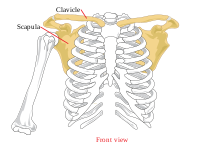
Photo from wikipedia
Purpose: To evaluate the short-term clinical and radiological outcomes with degenerative changes in patients over 40 years old following isolated vertical medial meniscal tear repair. Methods: Between 2007 and 2015,… Click to show full abstract
Purpose: To evaluate the short-term clinical and radiological outcomes with degenerative changes in patients over 40 years old following isolated vertical medial meniscal tear repair. Methods: Between 2007 and 2015, 438 patients underwent arthroscopic meniscal repair. Thirty-three patients aged over 40 years with isolated vertical medial meniscal repair (23 males and 10 females, mean age 46.1 ± 7.0; range 40–67) were included in the study. Preoperative and postoperative physical examination findings, Lysholm knee score, the International Knee Documentation Committee score, magnetic resonance imaging findings, and Kellgren–Lawrence osteoarthritis stage were evaluated. Results: The mean follow-up period was 31.1 months ± 20.1 (range 12–100 months). There was statistically significant improvement in functional scores (p < 0.05) and physical examination findings. In 22 patients (66.7%), improvement in the clinical and radiological results was detected (p < 0.05). However, no correlation was found between clinical and radiological outcomes. There was also no significant change in osteoarthritis stages at the last follow-up visit. No significant difference was found between smokers and nonsmokers regarding clinical outcomes. Conclusion: Successful clinical and radiological outcomes can be obtained following isolated vertical medial meniscal tear repair in patients older than 40 years. Age is not the sole criterion for the success of meniscal repair; rather, the functional capacity of the patient, the location of the tear, the grade of knee joint arthritis, and the quality of the meniscal tissue should be taken into consideration.
Journal Title: Journal of Orthopaedic Surgery
Year Published: 2019
Link to full text (if available)
Share on Social Media: Sign Up to like & get
recommendations!